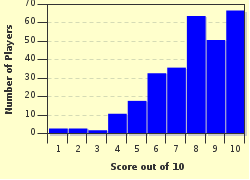Quiz Answer Key and Fun Facts
1. He was born on March 14th, 1879 in Ulm, Germany. Although he had early speech difficulties, it did not stop him from pursuing a career in mathematics and physics, and in 1905, at the age of 26, he developed his special theory of relativity, or E=mc˛. He died on April 18th, 1955 in Princeton, New Jersey, USA. He was aged 76. Who was he?
2. Born in Cullom, Illinois on April 10th, 1900, he was the son of a blacksmith. He developed a great interest in chemistry from childhood, such that in 1934, he devised the pH meter, a device for measuring acidity. In 1988, he was awarded the National Medal of Technology to be followed a year later with the National Medal of Science. He passed away in 2004 on May 18th in La Jolla, California. Who was he?
3. Born on August 30th, 1871, in Brightwater, New Zealand, he is known as the father of nuclear physics. In 1908, he was awarded the Nobel Prize in Chemistry due to "his investigations into the disintegration of the elements, and the chemistry of radioactive substances". In 1909, he directed an experiment to split the atom, later known as the gold foil experiment. He died on October 19th, 1937, at the age of 66, in Cambridge, England. Who was he?
4. He was born on November 25th , 1844, in Karlsruhe. He attended the scientifically orientated school, Lyzeum. At the age of 15, he passed an entrance exam for mechanical engineering at the University of Karlsruhe. He graduated when he was nineteen. He is widely regarded as the inventor of the gasoline-powered automobile, and in 1879 he was granted a patent for his first engine which he had designed in 1878. He died on April 14th, 1929 in Ladenberg, Germany. Who was he?
5. He was born on December 28th, 1798 in Dundee, Scotland. He was educated at the high school of Dundee. His love of astronomy took him to Africa in April 1832 where he discovered that the star, Alpha Centauri, had a large proper motion, which indicated to him that it was quite close. He then retired back to the United Kingdom. While in the UK, he concluded that Alpha Centauri was 3.25 light years away, although he didn't publish his findings because of his uncertainty about their accuracy. He died on November 23rd, 1844 in Edinburgh at the age of 46. Who was he?
6. Born on December 27th, 1822, in Dole, he was regarded as one of the three main founders of microbiology, and on April 12th in 1862, he discovered the process later called pasteurisation. Another of his discoveries was the rabies vaccine. He first tested it on a human on July 6th 1885, on a nine year old boy, Joseph Meister, who had been attacked and severely mauled by a rabid dog. He died near Paris on September 28th, 1895. He was 73 years of age. Who was he?
7. He was born in 1782 in Hounsfield, New York. In the winter of 1810-11, he attended the College of Physicians and Surgeons of New York (now Columbia University), and in the January of 1815, he attended lectures at the University of Pennsylvania. He then moved to Sacketts Harbour, Jefferson County, in the far north of New York state to become a country doctor. 14 years later, he discovered anaesthetic chloroform (tri-chloroform). He passed away in 1845. Who was he?
8. He was born in Chicago, Illinois on April 6th, 1928 and is known for his discovery of the structure of DNA. In 1956, he was appointed as a junior member of Harvard Universities Biological Laboratories. He was there until he resigned in 1976. During his stay there (in 1968), he also became director of Cold Spring Harbour Laboratories, where he studied cancer. In 1962, along with Francis Crick and Maurice Wilkins, he was awarded the Nobel Prize in Physiology or Medicine. Who is he?
9. He was born in Baku, Azerbaijan, on February 5th, 1879. He attended the universities of Zurich and Berlin and is known because of his contributions to the founding of colour television. The first experiment of colour television was in London in 1928 based on his tri-colour principle. He achieved this by further developing theoretical works by M. Le Blanc and P. Niptov. He passed away on September 12th, 1932. Who was he?
10. He was born on August 5th, 1884 in Warsaw, Poland. In 1902, he attended the University of Wurzburg and transferred to Berlin in 1904 to do papers in Medicine and Philosophy. He was then appointed assistant in cancer research at Heidelberg Institute for experimental cancer research under E. von Dungern. He soon discovered the heritability of blood groups. With the help of his friend, von Dungern, he changed the names of the blood types, I, II, III and IV to A, B, AB and O. He passed away on March 7th in 1954 at the age of 69. Who was he?
Source: Author
Orange_cats
This quiz was reviewed by FunTrivia editor
Snowman before going online.
Any errors found in FunTrivia content are routinely corrected through our feedback system.


